Change Management and Organisational Development for LPHY
VerifiedAdded on 2023/06/10
|8
|2465
|292
AI Summary
This report discusses the importance of change management in a business, with a focus on LPHY, a local charity firm. It identifies and rationalizes strategic changes that LPHY can take, outlines a planned change approach using a change management model, and addresses potential resistance to the proposed change plan. The report also provides recommendations for LPHY to expand its business.
Contribute Materials
Your contribution can guide someone’s learning journey. Share your
documents today.
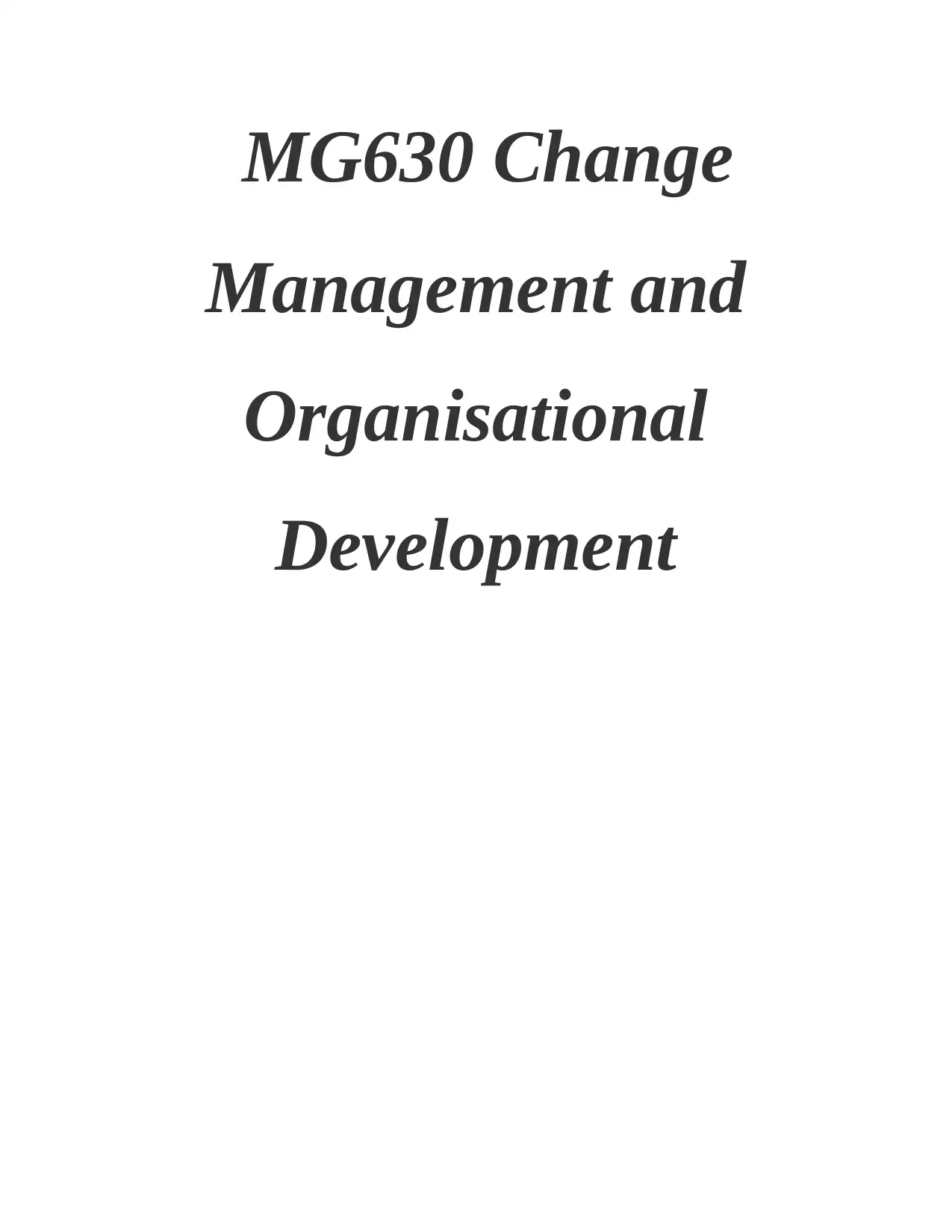
MG630 Change
Management and
Organisational
Development
Management and
Organisational
Development
Secure Best Marks with AI Grader
Need help grading? Try our AI Grader for instant feedback on your assignments.
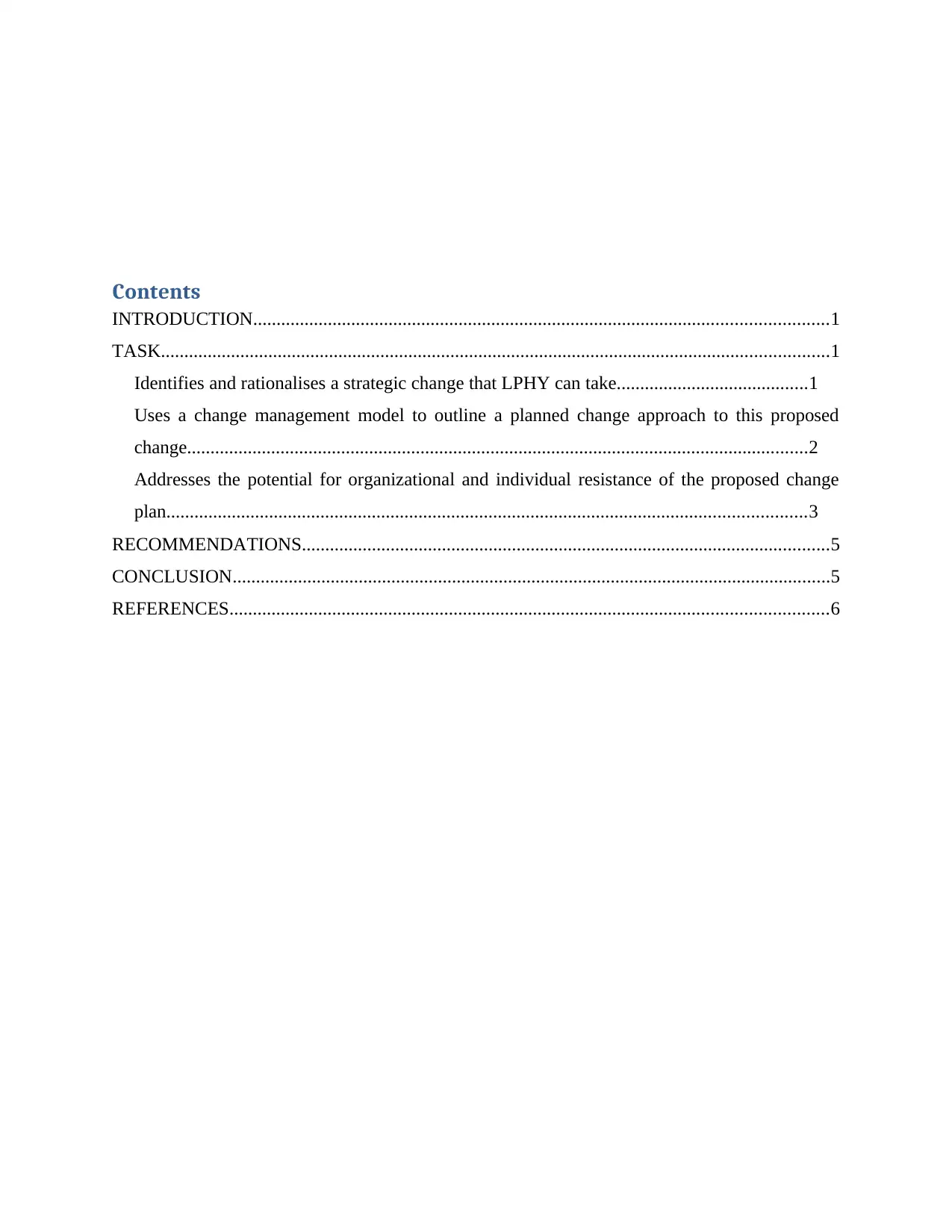
Contents
INTRODUCTION...........................................................................................................................1
TASK...............................................................................................................................................1
Identifies and rationalises a strategic change that LPHY can take.........................................1
Uses a change management model to outline a planned change approach to this proposed
change.....................................................................................................................................2
Addresses the potential for organizational and individual resistance of the proposed change
plan.........................................................................................................................................3
RECOMMENDATIONS.................................................................................................................5
CONCLUSION................................................................................................................................5
REFERENCES................................................................................................................................6
INTRODUCTION...........................................................................................................................1
TASK...............................................................................................................................................1
Identifies and rationalises a strategic change that LPHY can take.........................................1
Uses a change management model to outline a planned change approach to this proposed
change.....................................................................................................................................2
Addresses the potential for organizational and individual resistance of the proposed change
plan.........................................................................................................................................3
RECOMMENDATIONS.................................................................................................................5
CONCLUSION................................................................................................................................5
REFERENCES................................................................................................................................6
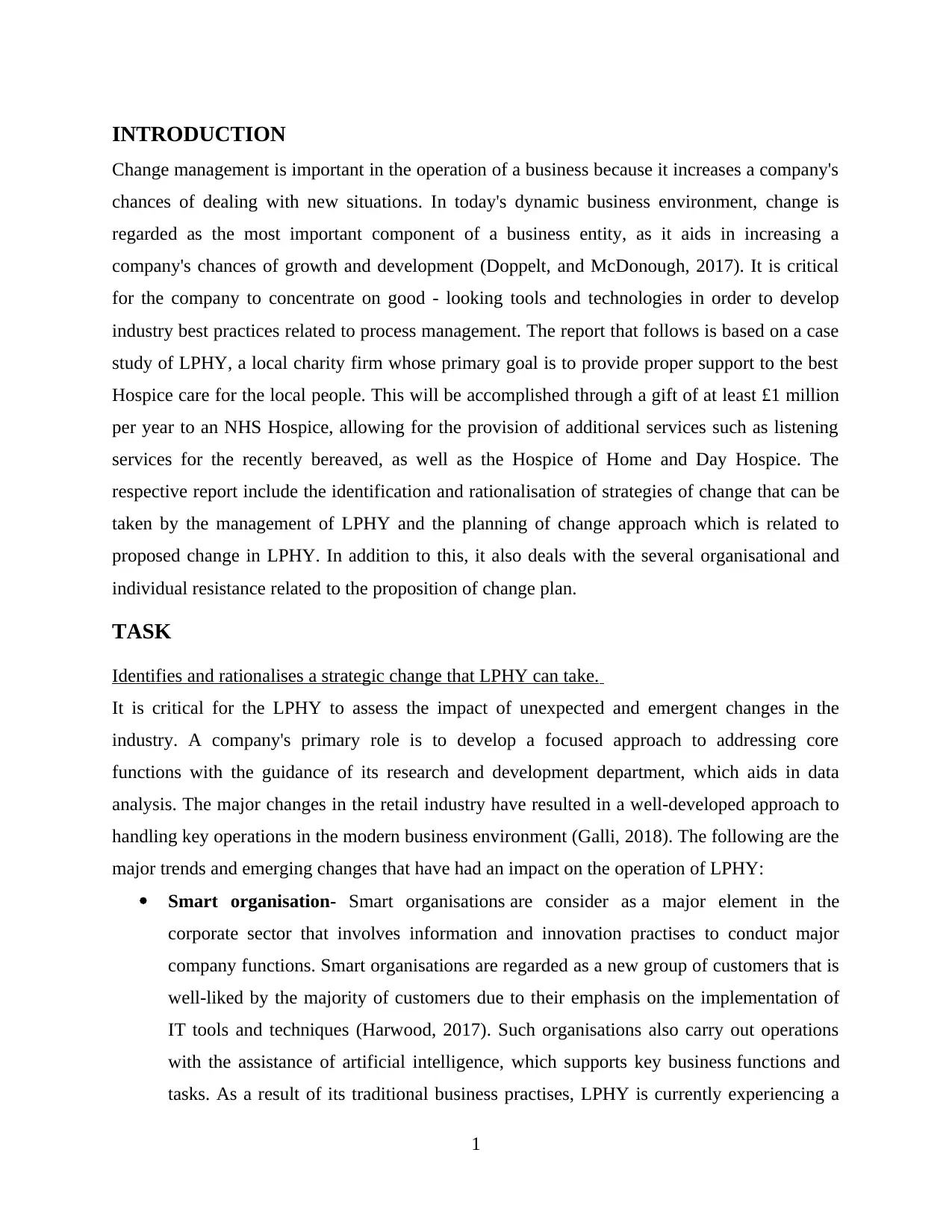
INTRODUCTION
Change management is important in the operation of a business because it increases a company's
chances of dealing with new situations. In today's dynamic business environment, change is
regarded as the most important component of a business entity, as it aids in increasing a
company's chances of growth and development (Doppelt, and McDonough, 2017). It is critical
for the company to concentrate on good - looking tools and technologies in order to develop
industry best practices related to process management. The report that follows is based on a case
study of LPHY, a local charity firm whose primary goal is to provide proper support to the best
Hospice care for the local people. This will be accomplished through a gift of at least £1 million
per year to an NHS Hospice, allowing for the provision of additional services such as listening
services for the recently bereaved, as well as the Hospice of Home and Day Hospice. The
respective report include the identification and rationalisation of strategies of change that can be
taken by the management of LPHY and the planning of change approach which is related to
proposed change in LPHY. In addition to this, it also deals with the several organisational and
individual resistance related to the proposition of change plan.
TASK
Identifies and rationalises a strategic change that LPHY can take.
It is critical for the LPHY to assess the impact of unexpected and emergent changes in the
industry. A company's primary role is to develop a focused approach to addressing core
functions with the guidance of its research and development department, which aids in data
analysis. The major changes in the retail industry have resulted in a well-developed approach to
handling key operations in the modern business environment (Galli, 2018). The following are the
major trends and emerging changes that have had an impact on the operation of LPHY:
Smart organisation- Smart organisations are consider as a major element in the
corporate sector that involves information and innovation practises to conduct major
company functions. Smart organisations are regarded as a new group of customers that is
well-liked by the majority of customers due to their emphasis on the implementation of
IT tools and techniques (Harwood, 2017). Such organisations also carry out operations
with the assistance of artificial intelligence, which supports key business functions and
tasks. As a result of its traditional business practises, LPHY is currently experiencing a
1
Change management is important in the operation of a business because it increases a company's
chances of dealing with new situations. In today's dynamic business environment, change is
regarded as the most important component of a business entity, as it aids in increasing a
company's chances of growth and development (Doppelt, and McDonough, 2017). It is critical
for the company to concentrate on good - looking tools and technologies in order to develop
industry best practices related to process management. The report that follows is based on a case
study of LPHY, a local charity firm whose primary goal is to provide proper support to the best
Hospice care for the local people. This will be accomplished through a gift of at least £1 million
per year to an NHS Hospice, allowing for the provision of additional services such as listening
services for the recently bereaved, as well as the Hospice of Home and Day Hospice. The
respective report include the identification and rationalisation of strategies of change that can be
taken by the management of LPHY and the planning of change approach which is related to
proposed change in LPHY. In addition to this, it also deals with the several organisational and
individual resistance related to the proposition of change plan.
TASK
Identifies and rationalises a strategic change that LPHY can take.
It is critical for the LPHY to assess the impact of unexpected and emergent changes in the
industry. A company's primary role is to develop a focused approach to addressing core
functions with the guidance of its research and development department, which aids in data
analysis. The major changes in the retail industry have resulted in a well-developed approach to
handling key operations in the modern business environment (Galli, 2018). The following are the
major trends and emerging changes that have had an impact on the operation of LPHY:
Smart organisation- Smart organisations are consider as a major element in the
corporate sector that involves information and innovation practises to conduct major
company functions. Smart organisations are regarded as a new group of customers that is
well-liked by the majority of customers due to their emphasis on the implementation of
IT tools and techniques (Harwood, 2017). Such organisations also carry out operations
with the assistance of artificial intelligence, which supports key business functions and
tasks. As a result of its traditional business practises, LPHY is currently experiencing a
1
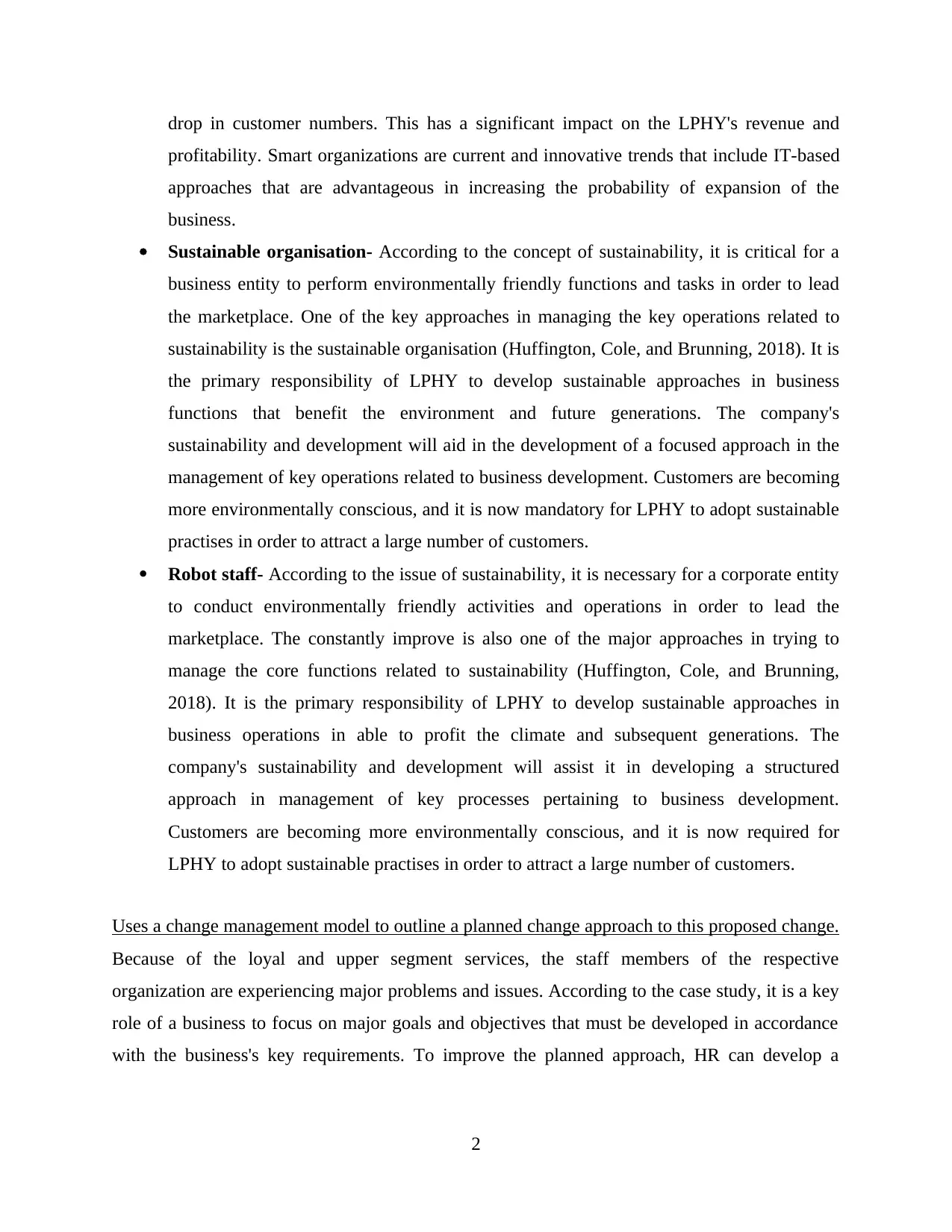
drop in customer numbers. This has a significant impact on the LPHY's revenue and
profitability. Smart organizations are current and innovative trends that include IT-based
approaches that are advantageous in increasing the probability of expansion of the
business.
Sustainable organisation- According to the concept of sustainability, it is critical for a
business entity to perform environmentally friendly functions and tasks in order to lead
the marketplace. One of the key approaches in managing the key operations related to
sustainability is the sustainable organisation (Huffington, Cole, and Brunning, 2018). It is
the primary responsibility of LPHY to develop sustainable approaches in business
functions that benefit the environment and future generations. The company's
sustainability and development will aid in the development of a focused approach in the
management of key operations related to business development. Customers are becoming
more environmentally conscious, and it is now mandatory for LPHY to adopt sustainable
practises in order to attract a large number of customers.
Robot staff- According to the issue of sustainability, it is necessary for a corporate entity
to conduct environmentally friendly activities and operations in order to lead the
marketplace. The constantly improve is also one of the major approaches in trying to
manage the core functions related to sustainability (Huffington, Cole, and Brunning,
2018). It is the primary responsibility of LPHY to develop sustainable approaches in
business operations in able to profit the climate and subsequent generations. The
company's sustainability and development will assist it in developing a structured
approach in management of key processes pertaining to business development.
Customers are becoming more environmentally conscious, and it is now required for
LPHY to adopt sustainable practises in order to attract a large number of customers.
Uses a change management model to outline a planned change approach to this proposed change.
Because of the loyal and upper segment services, the staff members of the respective
organization are experiencing major problems and issues. According to the case study, it is a key
role of a business to focus on major goals and objectives that must be developed in accordance
with the business's key requirements. To improve the planned approach, HR can develop a
2
profitability. Smart organizations are current and innovative trends that include IT-based
approaches that are advantageous in increasing the probability of expansion of the
business.
Sustainable organisation- According to the concept of sustainability, it is critical for a
business entity to perform environmentally friendly functions and tasks in order to lead
the marketplace. One of the key approaches in managing the key operations related to
sustainability is the sustainable organisation (Huffington, Cole, and Brunning, 2018). It is
the primary responsibility of LPHY to develop sustainable approaches in business
functions that benefit the environment and future generations. The company's
sustainability and development will aid in the development of a focused approach in the
management of key operations related to business development. Customers are becoming
more environmentally conscious, and it is now mandatory for LPHY to adopt sustainable
practises in order to attract a large number of customers.
Robot staff- According to the issue of sustainability, it is necessary for a corporate entity
to conduct environmentally friendly activities and operations in order to lead the
marketplace. The constantly improve is also one of the major approaches in trying to
manage the core functions related to sustainability (Huffington, Cole, and Brunning,
2018). It is the primary responsibility of LPHY to develop sustainable approaches in
business operations in able to profit the climate and subsequent generations. The
company's sustainability and development will assist it in developing a structured
approach in management of key processes pertaining to business development.
Customers are becoming more environmentally conscious, and it is now required for
LPHY to adopt sustainable practises in order to attract a large number of customers.
Uses a change management model to outline a planned change approach to this proposed change.
Because of the loyal and upper segment services, the staff members of the respective
organization are experiencing major problems and issues. According to the case study, it is a key
role of a business to focus on major goals and objectives that must be developed in accordance
with the business's key requirements. To improve the planned approach, HR can develop a
2
Secure Best Marks with AI Grader
Need help grading? Try our AI Grader for instant feedback on your assignments.
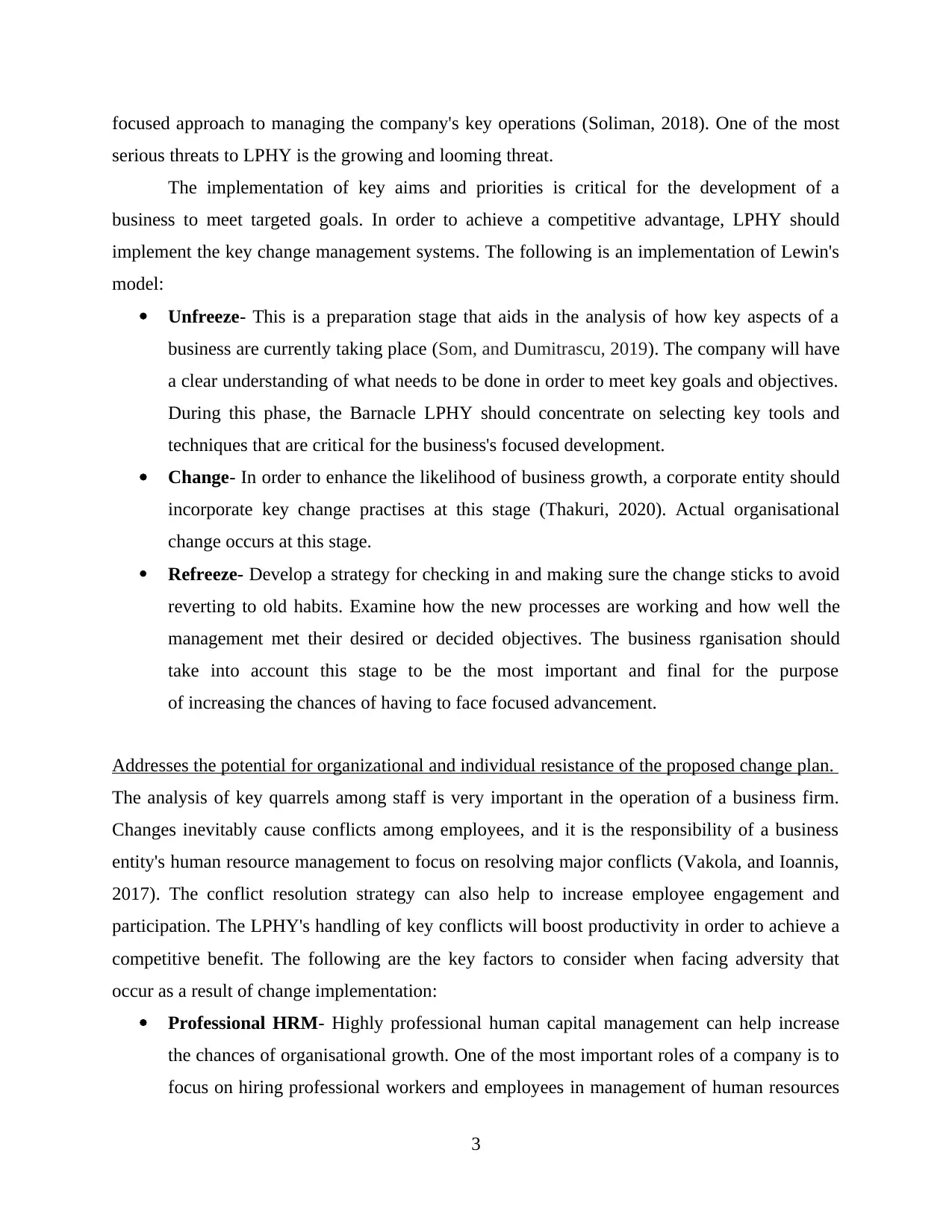
focused approach to managing the company's key operations (Soliman, 2018). One of the most
serious threats to LPHY is the growing and looming threat.
The implementation of key aims and priorities is critical for the development of a
business to meet targeted goals. In order to achieve a competitive advantage, LPHY should
implement the key change management systems. The following is an implementation of Lewin's
model:
Unfreeze- This is a preparation stage that aids in the analysis of how key aspects of a
business are currently taking place (Som, and Dumitrascu, 2019). The company will have
a clear understanding of what needs to be done in order to meet key goals and objectives.
During this phase, the Barnacle LPHY should concentrate on selecting key tools and
techniques that are critical for the business's focused development.
Change- In order to enhance the likelihood of business growth, a corporate entity should
incorporate key change practises at this stage (Thakuri, 2020). Actual organisational
change occurs at this stage.
Refreeze- Develop a strategy for checking in and making sure the change sticks to avoid
reverting to old habits. Examine how the new processes are working and how well the
management met their desired or decided objectives. The business rganisation should
take into account this stage to be the most important and final for the purpose
of increasing the chances of having to face focused advancement.
Addresses the potential for organizational and individual resistance of the proposed change plan.
The analysis of key quarrels among staff is very important in the operation of a business firm.
Changes inevitably cause conflicts among employees, and it is the responsibility of a business
entity's human resource management to focus on resolving major conflicts (Vakola, and Ioannis,
2017). The conflict resolution strategy can also help to increase employee engagement and
participation. The LPHY's handling of key conflicts will boost productivity in order to achieve a
competitive benefit. The following are the key factors to consider when facing adversity that
occur as a result of change implementation:
Professional HRM- Highly professional human capital management can help increase
the chances of organisational growth. One of the most important roles of a company is to
focus on hiring professional workers and employees in management of human resources
3
serious threats to LPHY is the growing and looming threat.
The implementation of key aims and priorities is critical for the development of a
business to meet targeted goals. In order to achieve a competitive advantage, LPHY should
implement the key change management systems. The following is an implementation of Lewin's
model:
Unfreeze- This is a preparation stage that aids in the analysis of how key aspects of a
business are currently taking place (Som, and Dumitrascu, 2019). The company will have
a clear understanding of what needs to be done in order to meet key goals and objectives.
During this phase, the Barnacle LPHY should concentrate on selecting key tools and
techniques that are critical for the business's focused development.
Change- In order to enhance the likelihood of business growth, a corporate entity should
incorporate key change practises at this stage (Thakuri, 2020). Actual organisational
change occurs at this stage.
Refreeze- Develop a strategy for checking in and making sure the change sticks to avoid
reverting to old habits. Examine how the new processes are working and how well the
management met their desired or decided objectives. The business rganisation should
take into account this stage to be the most important and final for the purpose
of increasing the chances of having to face focused advancement.
Addresses the potential for organizational and individual resistance of the proposed change plan.
The analysis of key quarrels among staff is very important in the operation of a business firm.
Changes inevitably cause conflicts among employees, and it is the responsibility of a business
entity's human resource management to focus on resolving major conflicts (Vakola, and Ioannis,
2017). The conflict resolution strategy can also help to increase employee engagement and
participation. The LPHY's handling of key conflicts will boost productivity in order to achieve a
competitive benefit. The following are the key factors to consider when facing adversity that
occur as a result of change implementation:
Professional HRM- Highly professional human capital management can help increase
the chances of organisational growth. One of the most important roles of a company is to
focus on hiring professional workers and employees in management of human resources
3
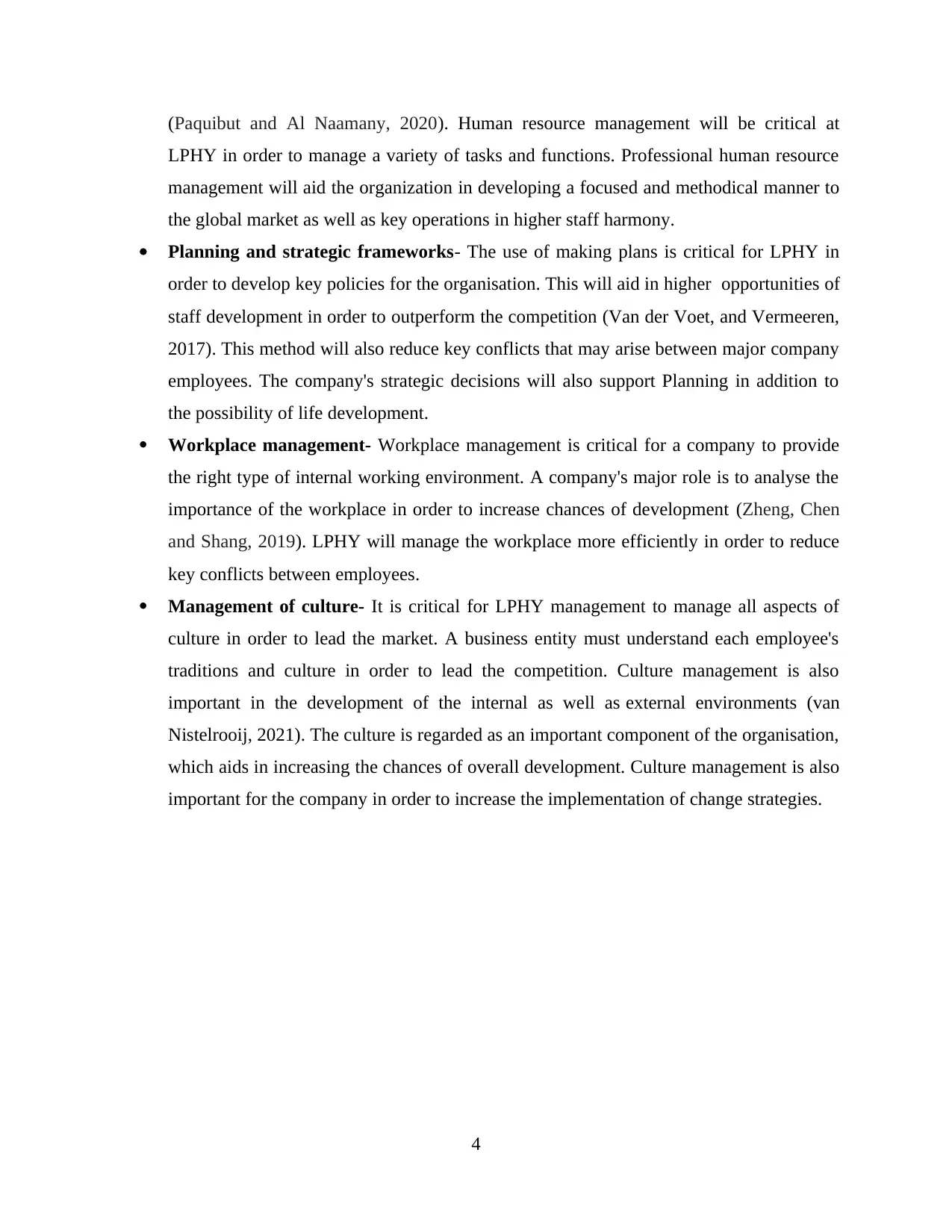
(Paquibut and Al Naamany, 2020). Human resource management will be critical at
LPHY in order to manage a variety of tasks and functions. Professional human resource
management will aid the organization in developing a focused and methodical manner to
the global market as well as key operations in higher staff harmony.
Planning and strategic frameworks- The use of making plans is critical for LPHY in
order to develop key policies for the organisation. This will aid in higher opportunities of
staff development in order to outperform the competition (Van der Voet, and Vermeeren,
2017). This method will also reduce key conflicts that may arise between major company
employees. The company's strategic decisions will also support Planning in addition to
the possibility of life development.
Workplace management- Workplace management is critical for a company to provide
the right type of internal working environment. A company's major role is to analyse the
importance of the workplace in order to increase chances of development (Zheng, Chen
and Shang, 2019). LPHY will manage the workplace more efficiently in order to reduce
key conflicts between employees.
Management of culture- It is critical for LPHY management to manage all aspects of
culture in order to lead the market. A business entity must understand each employee's
traditions and culture in order to lead the competition. Culture management is also
important in the development of the internal as well as external environments (van
Nistelrooij, 2021). The culture is regarded as an important component of the organisation,
which aids in increasing the chances of overall development. Culture management is also
important for the company in order to increase the implementation of change strategies.
4
LPHY in order to manage a variety of tasks and functions. Professional human resource
management will aid the organization in developing a focused and methodical manner to
the global market as well as key operations in higher staff harmony.
Planning and strategic frameworks- The use of making plans is critical for LPHY in
order to develop key policies for the organisation. This will aid in higher opportunities of
staff development in order to outperform the competition (Van der Voet, and Vermeeren,
2017). This method will also reduce key conflicts that may arise between major company
employees. The company's strategic decisions will also support Planning in addition to
the possibility of life development.
Workplace management- Workplace management is critical for a company to provide
the right type of internal working environment. A company's major role is to analyse the
importance of the workplace in order to increase chances of development (Zheng, Chen
and Shang, 2019). LPHY will manage the workplace more efficiently in order to reduce
key conflicts between employees.
Management of culture- It is critical for LPHY management to manage all aspects of
culture in order to lead the market. A business entity must understand each employee's
traditions and culture in order to lead the competition. Culture management is also
important in the development of the internal as well as external environments (van
Nistelrooij, 2021). The culture is regarded as an important component of the organisation,
which aids in increasing the chances of overall development. Culture management is also
important for the company in order to increase the implementation of change strategies.
4
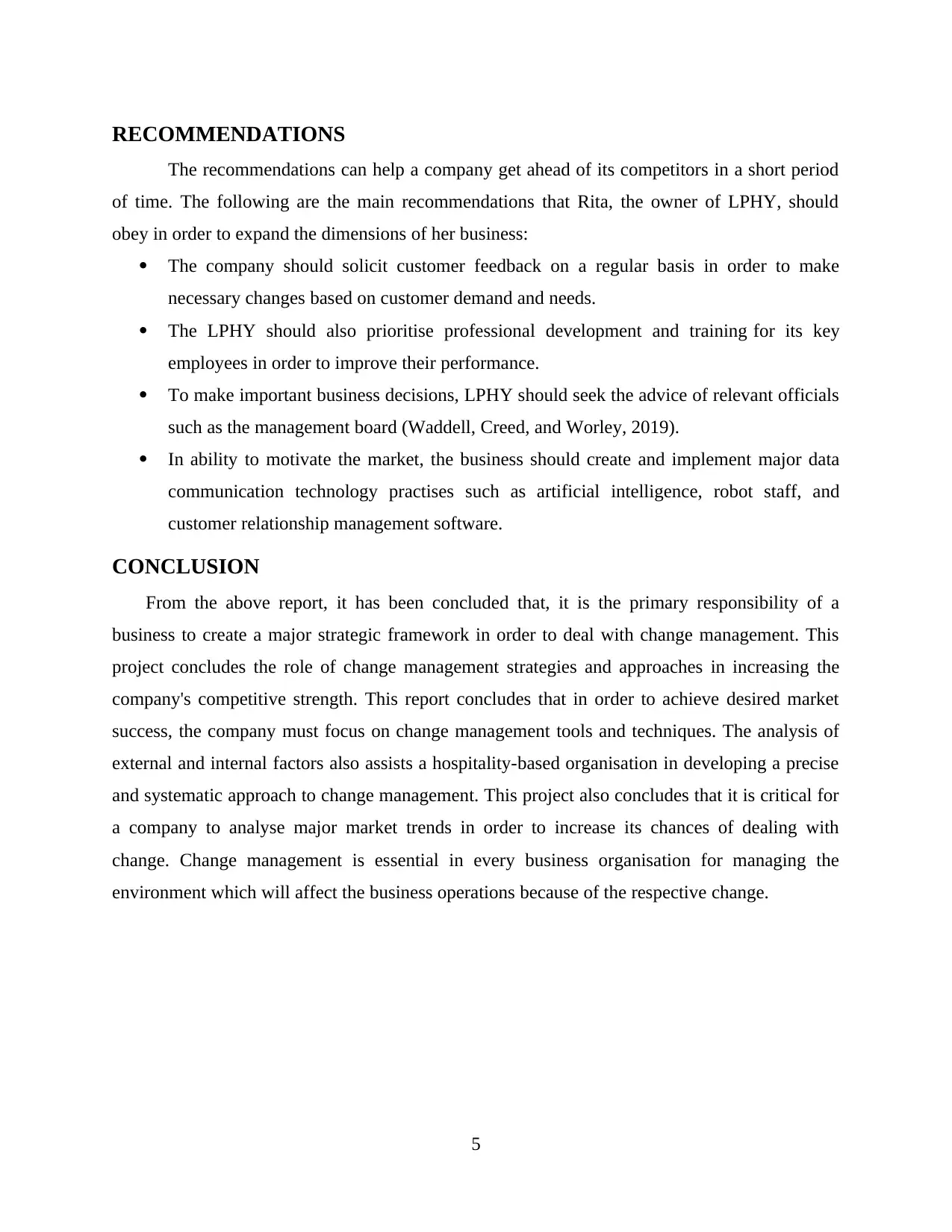
RECOMMENDATIONS
The recommendations can help a company get ahead of its competitors in a short period
of time. The following are the main recommendations that Rita, the owner of LPHY, should
obey in order to expand the dimensions of her business:
The company should solicit customer feedback on a regular basis in order to make
necessary changes based on customer demand and needs.
The LPHY should also prioritise professional development and training for its key
employees in order to improve their performance.
To make important business decisions, LPHY should seek the advice of relevant officials
such as the management board (Waddell, Creed, and Worley, 2019).
In ability to motivate the market, the business should create and implement major data
communication technology practises such as artificial intelligence, robot staff, and
customer relationship management software.
CONCLUSION
From the above report, it has been concluded that, it is the primary responsibility of a
business to create a major strategic framework in order to deal with change management. This
project concludes the role of change management strategies and approaches in increasing the
company's competitive strength. This report concludes that in order to achieve desired market
success, the company must focus on change management tools and techniques. The analysis of
external and internal factors also assists a hospitality-based organisation in developing a precise
and systematic approach to change management. This project also concludes that it is critical for
a company to analyse major market trends in order to increase its chances of dealing with
change. Change management is essential in every business organisation for managing the
environment which will affect the business operations because of the respective change.
5
The recommendations can help a company get ahead of its competitors in a short period
of time. The following are the main recommendations that Rita, the owner of LPHY, should
obey in order to expand the dimensions of her business:
The company should solicit customer feedback on a regular basis in order to make
necessary changes based on customer demand and needs.
The LPHY should also prioritise professional development and training for its key
employees in order to improve their performance.
To make important business decisions, LPHY should seek the advice of relevant officials
such as the management board (Waddell, Creed, and Worley, 2019).
In ability to motivate the market, the business should create and implement major data
communication technology practises such as artificial intelligence, robot staff, and
customer relationship management software.
CONCLUSION
From the above report, it has been concluded that, it is the primary responsibility of a
business to create a major strategic framework in order to deal with change management. This
project concludes the role of change management strategies and approaches in increasing the
company's competitive strength. This report concludes that in order to achieve desired market
success, the company must focus on change management tools and techniques. The analysis of
external and internal factors also assists a hospitality-based organisation in developing a precise
and systematic approach to change management. This project also concludes that it is critical for
a company to analyse major market trends in order to increase its chances of dealing with
change. Change management is essential in every business organisation for managing the
environment which will affect the business operations because of the respective change.
5
Paraphrase This Document
Need a fresh take? Get an instant paraphrase of this document with our AI Paraphraser
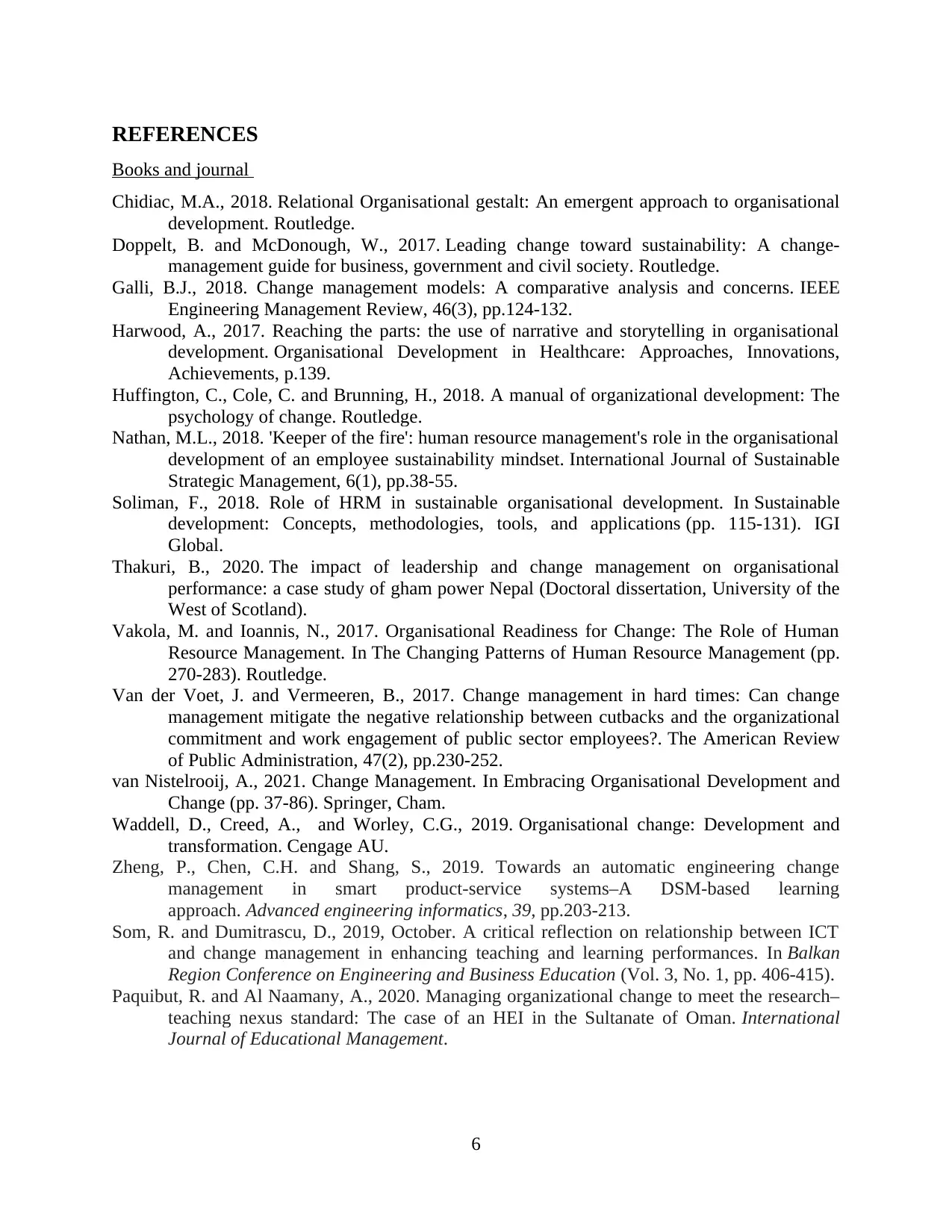
REFERENCES
Books and journal
Chidiac, M.A., 2018. Relational Organisational gestalt: An emergent approach to organisational
development. Routledge.
Doppelt, B. and McDonough, W., 2017. Leading change toward sustainability: A change-
management guide for business, government and civil society. Routledge.
Galli, B.J., 2018. Change management models: A comparative analysis and concerns. IEEE
Engineering Management Review, 46(3), pp.124-132.
Harwood, A., 2017. Reaching the parts: the use of narrative and storytelling in organisational
development. Organisational Development in Healthcare: Approaches, Innovations,
Achievements, p.139.
Huffington, C., Cole, C. and Brunning, H., 2018. A manual of organizational development: The
psychology of change. Routledge.
Nathan, M.L., 2018. 'Keeper of the fire': human resource management's role in the organisational
development of an employee sustainability mindset. International Journal of Sustainable
Strategic Management, 6(1), pp.38-55.
Soliman, F., 2018. Role of HRM in sustainable organisational development. In Sustainable
development: Concepts, methodologies, tools, and applications (pp. 115-131). IGI
Global.
Thakuri, B., 2020. The impact of leadership and change management on organisational
performance: a case study of gham power Nepal (Doctoral dissertation, University of the
West of Scotland).
Vakola, M. and Ioannis, N., 2017. Organisational Readiness for Change: The Role of Human
Resource Management. In The Changing Patterns of Human Resource Management (pp.
270-283). Routledge.
Van der Voet, J. and Vermeeren, B., 2017. Change management in hard times: Can change
management mitigate the negative relationship between cutbacks and the organizational
commitment and work engagement of public sector employees?. The American Review
of Public Administration, 47(2), pp.230-252.
van Nistelrooij, A., 2021. Change Management. In Embracing Organisational Development and
Change (pp. 37-86). Springer, Cham.
Waddell, D., Creed, A., and Worley, C.G., 2019. Organisational change: Development and
transformation. Cengage AU.
Zheng, P., Chen, C.H. and Shang, S., 2019. Towards an automatic engineering change
management in smart product-service systems–A DSM-based learning
approach. Advanced engineering informatics, 39, pp.203-213.
Som, R. and Dumitrascu, D., 2019, October. A critical reflection on relationship between ICT
and change management in enhancing teaching and learning performances. In Balkan
Region Conference on Engineering and Business Education (Vol. 3, No. 1, pp. 406-415).
Paquibut, R. and Al Naamany, A., 2020. Managing organizational change to meet the research–
teaching nexus standard: The case of an HEI in the Sultanate of Oman. International
Journal of Educational Management.
6
Books and journal
Chidiac, M.A., 2018. Relational Organisational gestalt: An emergent approach to organisational
development. Routledge.
Doppelt, B. and McDonough, W., 2017. Leading change toward sustainability: A change-
management guide for business, government and civil society. Routledge.
Galli, B.J., 2018. Change management models: A comparative analysis and concerns. IEEE
Engineering Management Review, 46(3), pp.124-132.
Harwood, A., 2017. Reaching the parts: the use of narrative and storytelling in organisational
development. Organisational Development in Healthcare: Approaches, Innovations,
Achievements, p.139.
Huffington, C., Cole, C. and Brunning, H., 2018. A manual of organizational development: The
psychology of change. Routledge.
Nathan, M.L., 2018. 'Keeper of the fire': human resource management's role in the organisational
development of an employee sustainability mindset. International Journal of Sustainable
Strategic Management, 6(1), pp.38-55.
Soliman, F., 2018. Role of HRM in sustainable organisational development. In Sustainable
development: Concepts, methodologies, tools, and applications (pp. 115-131). IGI
Global.
Thakuri, B., 2020. The impact of leadership and change management on organisational
performance: a case study of gham power Nepal (Doctoral dissertation, University of the
West of Scotland).
Vakola, M. and Ioannis, N., 2017. Organisational Readiness for Change: The Role of Human
Resource Management. In The Changing Patterns of Human Resource Management (pp.
270-283). Routledge.
Van der Voet, J. and Vermeeren, B., 2017. Change management in hard times: Can change
management mitigate the negative relationship between cutbacks and the organizational
commitment and work engagement of public sector employees?. The American Review
of Public Administration, 47(2), pp.230-252.
van Nistelrooij, A., 2021. Change Management. In Embracing Organisational Development and
Change (pp. 37-86). Springer, Cham.
Waddell, D., Creed, A., and Worley, C.G., 2019. Organisational change: Development and
transformation. Cengage AU.
Zheng, P., Chen, C.H. and Shang, S., 2019. Towards an automatic engineering change
management in smart product-service systems–A DSM-based learning
approach. Advanced engineering informatics, 39, pp.203-213.
Som, R. and Dumitrascu, D., 2019, October. A critical reflection on relationship between ICT
and change management in enhancing teaching and learning performances. In Balkan
Region Conference on Engineering and Business Education (Vol. 3, No. 1, pp. 406-415).
Paquibut, R. and Al Naamany, A., 2020. Managing organizational change to meet the research–
teaching nexus standard: The case of an HEI in the Sultanate of Oman. International
Journal of Educational Management.
6
1 out of 8
Related Documents
Your All-in-One AI-Powered Toolkit for Academic Success.
+13062052269
info@desklib.com
Available 24*7 on WhatsApp / Email
![[object Object]](/_next/static/media/star-bottom.7253800d.svg)
Unlock your academic potential
© 2024 | Zucol Services PVT LTD | All rights reserved.

